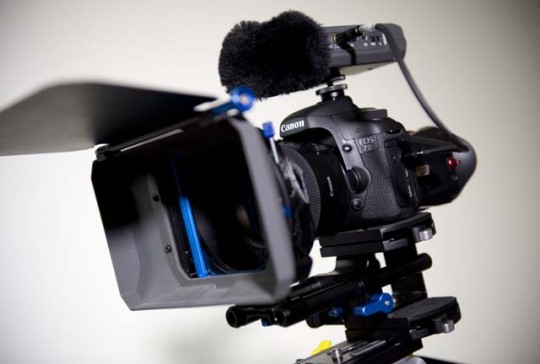5 Disruptive Technologies of 2010 - Part 3 : DSLR video
 Sunday, December 5, 2010 at 9:51AM
Sunday, December 5, 2010 at 9:51AM 

It is 2010 and DSLR (Digital Single Lens Reflex) cameras have proven to be surprisingly capable at handling HD video. Despite the odd, um, camera shape, DSLRs outfitted with the right equipment can rival and at times surpass standalone digital video cameras in terms of quality and their compact size.
A few years ago, good video quality on digital cameras was an exotic feature. While some cameras could muster the ability to shoot decent video, there were unreasonable time limitations and a lot of fiddling was required since there was no way to independently control video functions such as auto-focus and tracking.
This has all changed with the latest prosumer and pro-level DSLRs. Tap into the rich arsenal of available lenses, strap it on to a tripod and get a good quality microphone input and you'll have a more than acceptable video solution. Just check out the astonishing videos of Vincent Laforet who shoots with a Canon 5D MKII, the same camera used for last Season's finale of House which required filming in an extremely tight area (rubble of a collapsed building).
Some of the technology of that 5D Mark II has trickled down the Canon line to the 7D as well as the sub $1,000 Canon T2i/550D ( Canadianreviewer.com's field camera for stills and for many of our videos). Now, even some of the smaller compact cameras with interchangeable lenses are offering up the ability to shoot HD. You'll notice some of these companies like Olympus will even create tv commercials using the cameras they are promoting in order to show the HD capability and broadcast quality that they are capable of.
What should DSLR buyers looking partially into shooting videos look out for? We suggest you forget about Megapixel count and focus on the camera's sensor size. The 21Megapixel full-frame sensor of the Canon 5D Mark II is equivalen to 35mm film and also manages an ISO range of up to 6400 which can work well in extreme low-light conditions.
The selection of lenses is also a consideration for getting good video. The ability to add audio input, lighting and tripods is also important.
What then of standalone consumer video cameras, how will this affect their position? Most consumer video cameras, unfortunately, have small sensors. While these may manage HD video, the quality is almost always lacking. These cameras are designed for portability and ease of use and while some take still photographs, they are usually less than impressive.
A good DSLR with video capability and a decent lens is certainly more desirable than a $100-$400 video camera. But it really depends on what you are going to do with the video.
THe HD video capability of today's DSLRs will definitely open more opportunities for amateur and prosumer filmmakers looking into high quality video output at a relatively affordable price. That these video-capable cameras can take stunning photos as well is also a big bonus.




















Reader Comments